-
 Bitcoin
Bitcoin $107,323.9971
-0.42% -
 Ethereum
Ethereum $2,442.7415
-1.58% -
 Tether USDt
Tether USDt $1.0005
0.00% -
 XRP
XRP $2.0902
-4.49% -
 BNB
BNB $645.3561
-0.33% -
 Solana
Solana $140.8832
-2.81% -
 USDC
USDC $0.9999
0.01% -
 TRON
TRON $0.2713
0.17% -
 Dogecoin
Dogecoin $0.1611
-2.35% -
 Cardano
Cardano $0.5556
-2.75% -
 Hyperliquid
Hyperliquid $36.8045
-1.10% -
 Bitcoin Cash
Bitcoin Cash $494.4393
-1.23% -
 Sui
Sui $2.6406
-2.97% -
 Chainlink
Chainlink $13.0846
-1.74% -
 UNUS SED LEO
UNUS SED LEO $9.0127
0.09% -
 Avalanche
Avalanche $17.4023
-1.37% -
 Stellar
Stellar $0.2339
-3.25% -
 Toncoin
Toncoin $2.8330
-0.57% -
 Shiba Inu
Shiba Inu $0.0...01124
-3.38% -
 Litecoin
Litecoin $84.9229
-0.60% -
 Hedera
Hedera $0.1432
-3.84% -
 Monero
Monero $311.0740
-1.35% -
 Bitget Token
Bitget Token $4.6591
3.94% -
 Dai
Dai $1.0001
0.01% -
 Ethena USDe
Ethena USDe $1.0000
-0.01% -
 Polkadot
Polkadot $3.3033
-1.64% -
 Uniswap
Uniswap $6.9221
-4.55% -
 Pi
Pi $0.5546
-4.86% -
 Aave
Aave $257.5046
-1.30% -
 Pepe
Pepe $0.0...09215
-3.26%
Does a long lower shadow at the weekly level represent a bottom confirmation?
A long lower shadow on a weekly candle may signal weakening selling pressure, but confirmation through volume and follow-through is crucial for traders seeking reliable reversals.
Jun 27, 2025 at 10:56 am
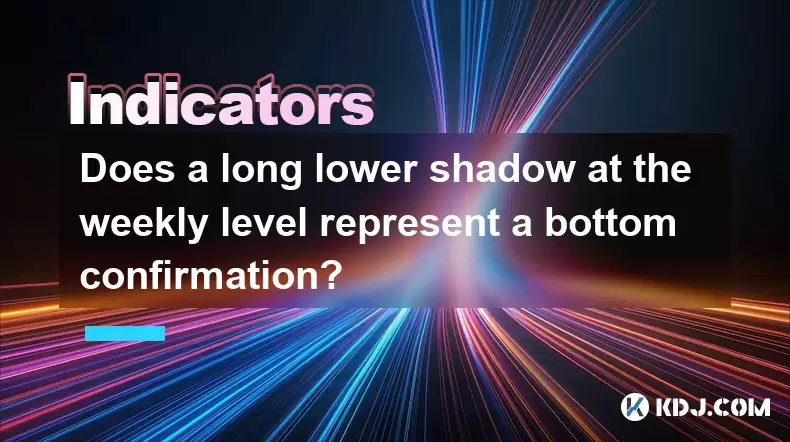
Understanding the Weekly Lower Shadow in Candlestick Analysis
In cryptocurrency trading, weekly candlestick patterns are often scrutinized for potential trend reversals. A long lower shadow at the weekly level indicates that during the week, sellers pushed prices down significantly but were met with strong buying pressure that closed the candle near its opening price or higher. This pattern is commonly interpreted as a sign of potential bullish reversal, especially if it appears after a prolonged downtrend.
However, while this formation can be promising, it should not be viewed in isolation. Traders must cross-verify such signals using other technical indicators and volume analysis to confirm whether a bottom is indeed forming.
Important: The presence of a long lower shadow does not guarantee a reversal—it merely suggests that selling pressure may be weakening.
Historical Context: Long Lower Shadows and Market Reversals
Looking back at historical Bitcoin and Ethereum charts, there have been instances where a long lower shadow on the weekly chart preceded significant rallies. For example, during the 2018–2019 bear market, Bitcoin formed a long-legged doji with a deep lower shadow on the weekly timeframe, which later marked the beginning of a new bull phase.
These occurrences suggest that when institutional or large retail buyers step in after heavy selloffs, they absorb the selling pressure and push prices back up, creating a visible rejection of lower levels. However, it's crucial to note that such formations often require time and additional confirmation signals before a full-fledged reversal occurs.
- Look for increased volume during the formation of the lower shadow
- Check for confluence with key support levels, such as previous resistance zones or Fibonacci retracements
- Monitor moving averages—a retest of the 200-week moving average with a long lower shadow can be particularly significant
Differentiating Between a Fakeout and a Genuine Bottom Signal
Not every long lower shadow leads to a sustainable reversal. In highly volatile crypto markets, false signals are common. Sometimes, whales or bots manipulate the price to trigger stop losses before reversing sharply upward, creating what's known as a **"fake break."
To distinguish between a fakeout and a genuine signal:
- Examine wick size relative to body size—the longer the shadow compared to the real body, the stronger the rejection
- Analyze order book depth to see if there was actual liquidity absorption at those lower levels
- Observe follow-through in subsequent weeks—a true reversal usually sees higher closes and bullish momentum continuing into the next candles
A single candle, no matter how impressive, cannot confirm a bottom without follow-through from the broader market structure.
Combining Weekly Signals with Daily and 4-Hour Charts
For traders seeking more precise entries, aligning the weekly long lower shadow with setups on shorter timeframes can improve accuracy. If the weekly candle shows a strong rejection of lows, traders might look for bullish engulfing patterns or hammer formations on the daily or 4-hour charts to enter positions with tighter stops.
This multi-timeframe approach allows traders to benefit from both the macro-level sentiment and micro-level timing. Additionally:
- Use RSI divergence on the daily chart to assess whether momentum supports a reversal
- Watch for accumulation patterns like ascending triangles or cup-and-handle formations
- Set stop-losses below the shadow’s low if entering based on the weekly signal
Such integration helps avoid premature entries and increases the probability of catching a legitimate trend reversal.
Common Pitfalls When Interpreting Weekly Shadows
Many novice traders fall into the trap of overreacting to a single candlestick formation. It's easy to get excited when a long lower shadow appears on the weekly chart, especially after a painful downtrend. However, several pitfalls can lead to poor decision-making:
- Misinterpreting volatility as strength—a sharp drop followed by a quick bounce doesn’t always mean a bottom is in
- Neglecting broader market conditions—if altcoins or equities are still under pressure, Bitcoin might not sustain a rally even with a bullish candle
- Failing to adjust risk parameters—traders sometimes take oversized positions based on hopeful assumptions rather than confirmed trends
Avoiding these mistakes requires discipline and a structured trading plan that incorporates multiple layers of analysis.
FAQs
Q: Can a weekly hammer candle alone confirm a bottom?
A: No, a hammer candle—even on the weekly chart—should be used in conjunction with other tools such as volume, trendlines, and oscillator readings to increase confidence in a reversal.
Q: How long should I wait for confirmation after seeing a long lower shadow?
A: Typically, one to two weeks of follow-through price action above the hammer’s close provides stronger evidence that the market has accepted the new value area.
Q: Are long lower shadows more reliable in certain market cycles?
A: These signals tend to be more reliable after extended bear markets or during capitulation phases, where emotional selling exhaustion is likely.
Q: Should I use leverage when trading off a weekly long lower shadow?
A: Leverage should be used cautiously. Given the size of weekly candles, slippage and liquidation risks increase, especially in less liquid altcoins.
Disclaimer:info@kdj.com
The information provided is not trading advice. kdj.com does not assume any responsibility for any investments made based on the information provided in this article. Cryptocurrencies are highly volatile and it is highly recommended that you invest with caution after thorough research!
If you believe that the content used on this website infringes your copyright, please contact us immediately (info@kdj.com) and we will delete it promptly.
- Nintendo's Rare Sale: A Treat for Switch Gamers!
- 2025-06-27 18:30:12
- Crypto, Stablecoins, and the European Commission: Navigating the Regulatory Landscape
- 2025-06-27 19:27:14
- Neo Pepe Coin's Presale Heats Up Amidst Market Shifts: The Next Big Meme Coin?
- 2025-06-27 19:10:12
- Crypto Fundraising H1 Peak: Successful Closings Signal a Bullish Turn
- 2025-06-27 20:10:12
- Cathie Wood, Coinbase, and ATH: What's Driving the Crypto Buzz?
- 2025-06-27 20:10:12
- Cambridge Investment, Coinbase, and Stock Holdings: What's the Deal?
- 2025-06-27 18:30:12
Related knowledge
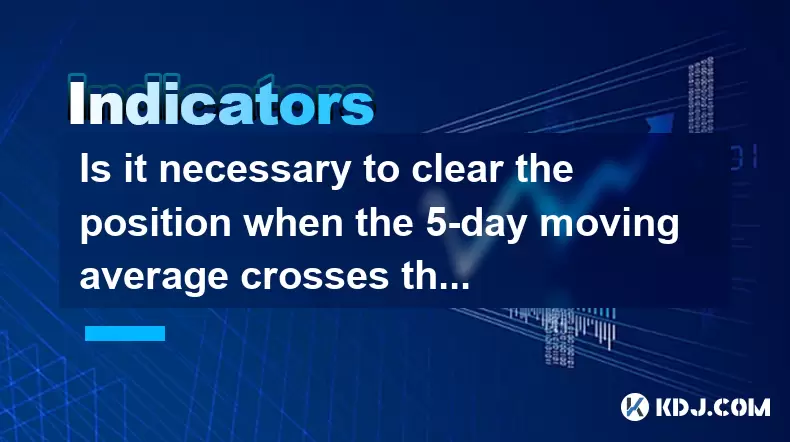
Is it necessary to clear the position when the 5-day moving average crosses the 10-day moving average?
Jun 27,2025 at 07:21pm
Understanding the 5-Day and 10-Day Moving AveragesIn the realm of technical analysis within the cryptocurrency market, moving averages play a crucial role in identifying trends and potential reversal points. The 5-day moving average (MA) and 10-day moving average are two of the most commonly used short-term indicators by traders. These tools smooth out ...
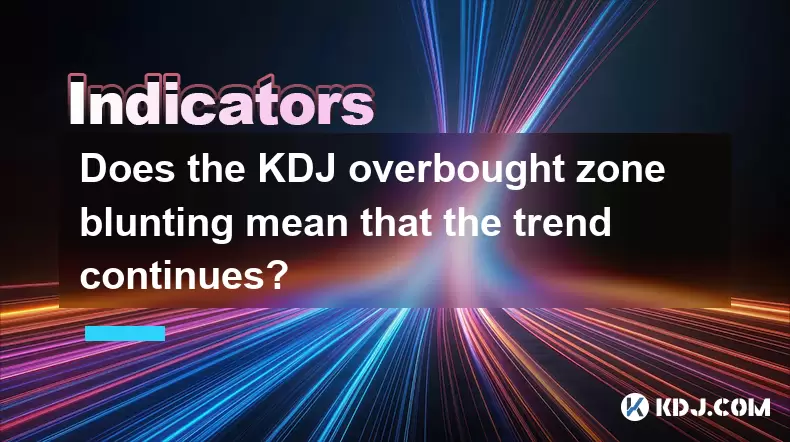
Does the KDJ overbought zone blunting mean that the trend continues?
Jun 27,2025 at 03:35pm
Understanding the KDJ Indicator in Cryptocurrency TradingThe KDJ indicator, also known as the stochastic oscillator, is a popular technical analysis tool used by traders to identify overbought or oversold conditions in asset prices. In the cryptocurrency market, where volatility is high and trends can change rapidly, understanding how to interpret the K...
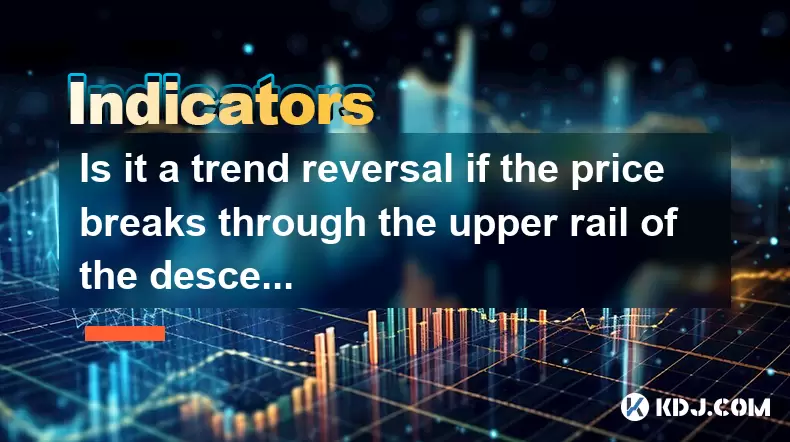
Is it a trend reversal if the price breaks through the upper rail of the descending channel and then steps back without breaking?
Jun 27,2025 at 05:35pm
Understanding the Descending Channel PatternA descending channel is a technical analysis pattern formed by two parallel downward-sloping trendlines, one acting as resistance and the other as support. This pattern typically indicates a continuation of a downtrend, where price action oscillates between these two boundaries. Traders often look for breakout...
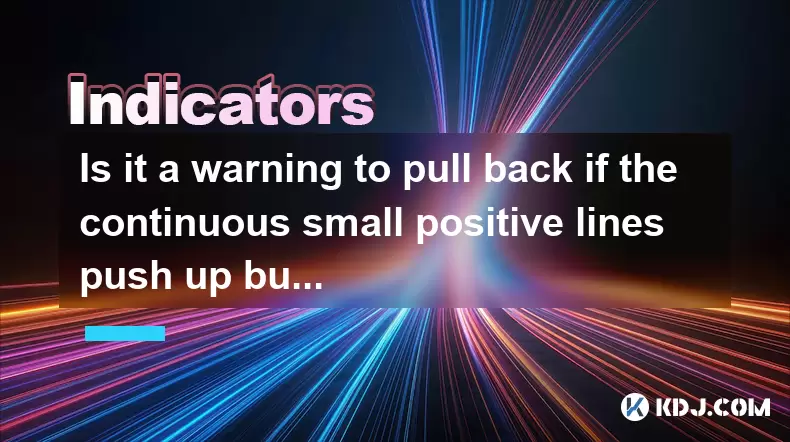
Is it a warning to pull back if the continuous small positive lines push up but the volume is insufficient?
Jun 27,2025 at 05:28pm
Understanding the Pattern: Continuous Small Positive LinesIn technical analysis, continuous small positive lines refer to a series of candlesticks where each candle closes slightly higher than its open. These candles usually have short wicks and indicate a gradual upward movement in price. Traders often interpret this pattern as a sign of steady buying ...
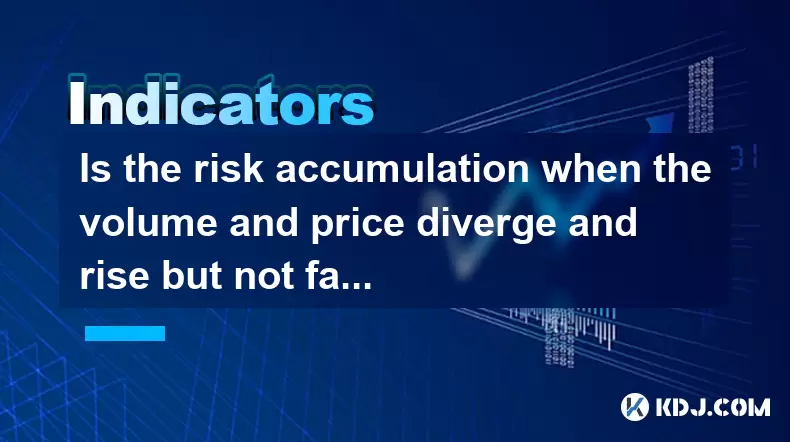
Is the risk accumulation when the volume and price diverge and rise but not fall?
Jun 27,2025 at 04:28pm
Understanding Volume and Price Divergence in Cryptocurrency TradingIn cryptocurrency trading, the relationship between volume and price plays a critical role in identifying market sentiment. When volume increases while price rises, it typically signals strong buying pressure and healthy market participation. However, when this correlation breaks—especia...
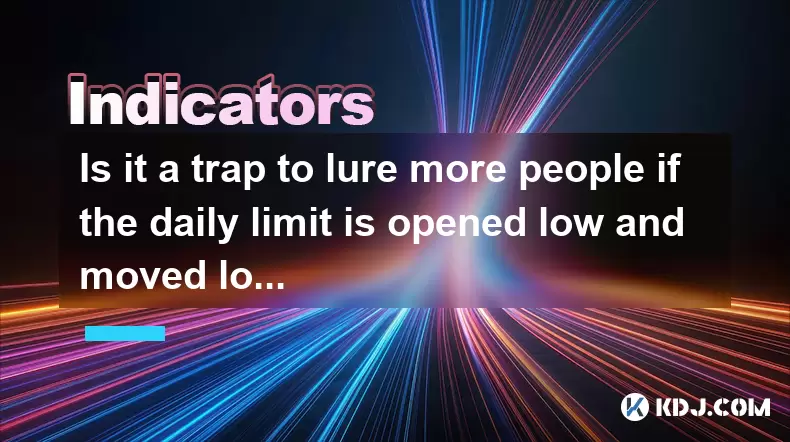
Is it a trap to lure more people if the daily limit is opened low and moved low the next day?
Jun 27,2025 at 08:21pm
Understanding the Mechanics of Daily Limits in Cryptocurrency TradingIn cryptocurrency trading, daily limits refer to the maximum percentage by which a digital asset’s price can rise or fall within a 24-hour period. These limits are often implemented by exchanges to prevent extreme volatility and protect traders from sudden, drastic losses. When a coin ...

Is it necessary to clear the position when the 5-day moving average crosses the 10-day moving average?
Jun 27,2025 at 07:21pm
Understanding the 5-Day and 10-Day Moving AveragesIn the realm of technical analysis within the cryptocurrency market, moving averages play a crucial role in identifying trends and potential reversal points. The 5-day moving average (MA) and 10-day moving average are two of the most commonly used short-term indicators by traders. These tools smooth out ...

Does the KDJ overbought zone blunting mean that the trend continues?
Jun 27,2025 at 03:35pm
Understanding the KDJ Indicator in Cryptocurrency TradingThe KDJ indicator, also known as the stochastic oscillator, is a popular technical analysis tool used by traders to identify overbought or oversold conditions in asset prices. In the cryptocurrency market, where volatility is high and trends can change rapidly, understanding how to interpret the K...

Is it a trend reversal if the price breaks through the upper rail of the descending channel and then steps back without breaking?
Jun 27,2025 at 05:35pm
Understanding the Descending Channel PatternA descending channel is a technical analysis pattern formed by two parallel downward-sloping trendlines, one acting as resistance and the other as support. This pattern typically indicates a continuation of a downtrend, where price action oscillates between these two boundaries. Traders often look for breakout...

Is it a warning to pull back if the continuous small positive lines push up but the volume is insufficient?
Jun 27,2025 at 05:28pm
Understanding the Pattern: Continuous Small Positive LinesIn technical analysis, continuous small positive lines refer to a series of candlesticks where each candle closes slightly higher than its open. These candles usually have short wicks and indicate a gradual upward movement in price. Traders often interpret this pattern as a sign of steady buying ...

Is the risk accumulation when the volume and price diverge and rise but not fall?
Jun 27,2025 at 04:28pm
Understanding Volume and Price Divergence in Cryptocurrency TradingIn cryptocurrency trading, the relationship between volume and price plays a critical role in identifying market sentiment. When volume increases while price rises, it typically signals strong buying pressure and healthy market participation. However, when this correlation breaks—especia...

Is it a trap to lure more people if the daily limit is opened low and moved low the next day?
Jun 27,2025 at 08:21pm
Understanding the Mechanics of Daily Limits in Cryptocurrency TradingIn cryptocurrency trading, daily limits refer to the maximum percentage by which a digital asset’s price can rise or fall within a 24-hour period. These limits are often implemented by exchanges to prevent extreme volatility and protect traders from sudden, drastic losses. When a coin ...
See all articles























































































